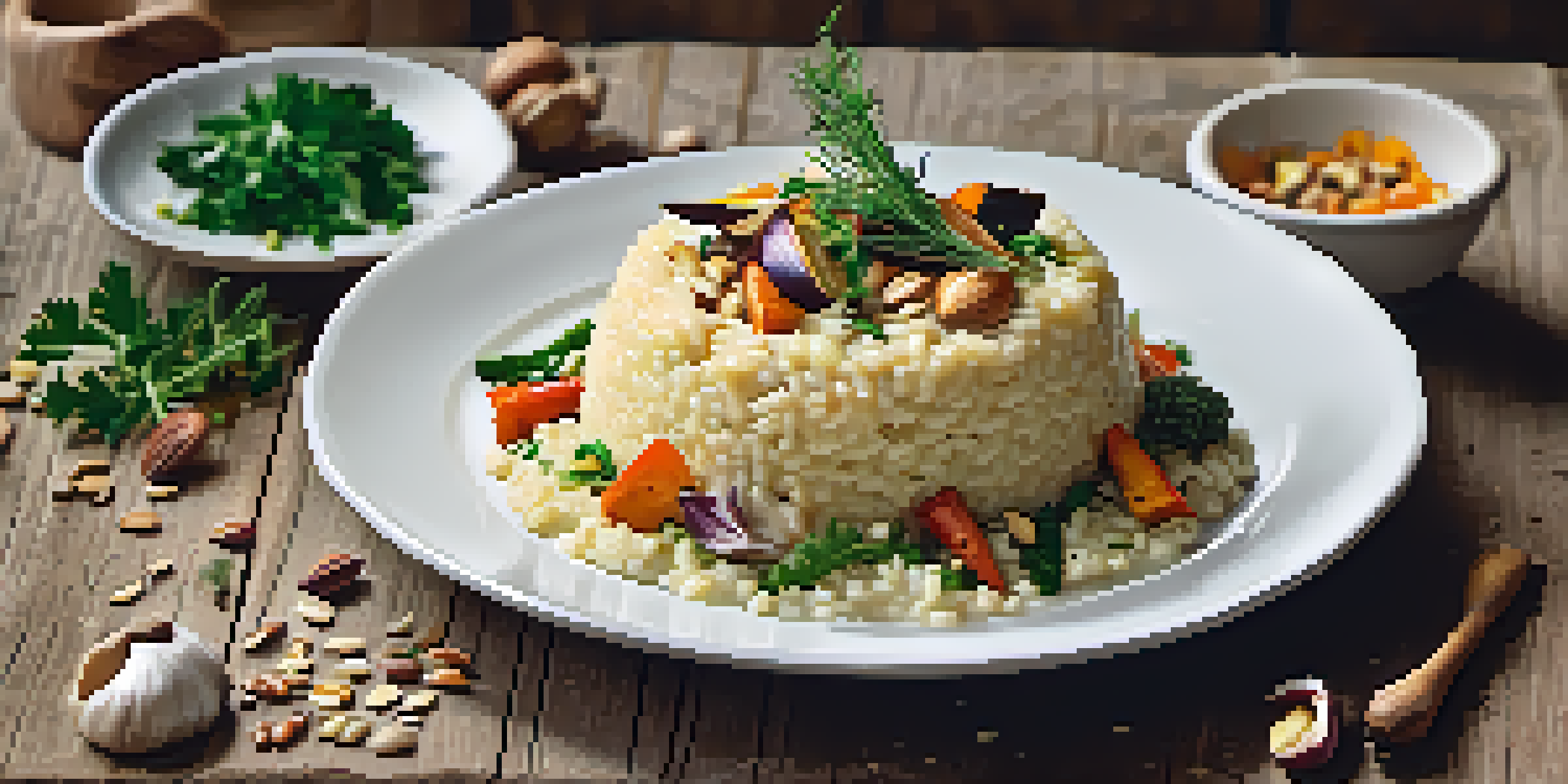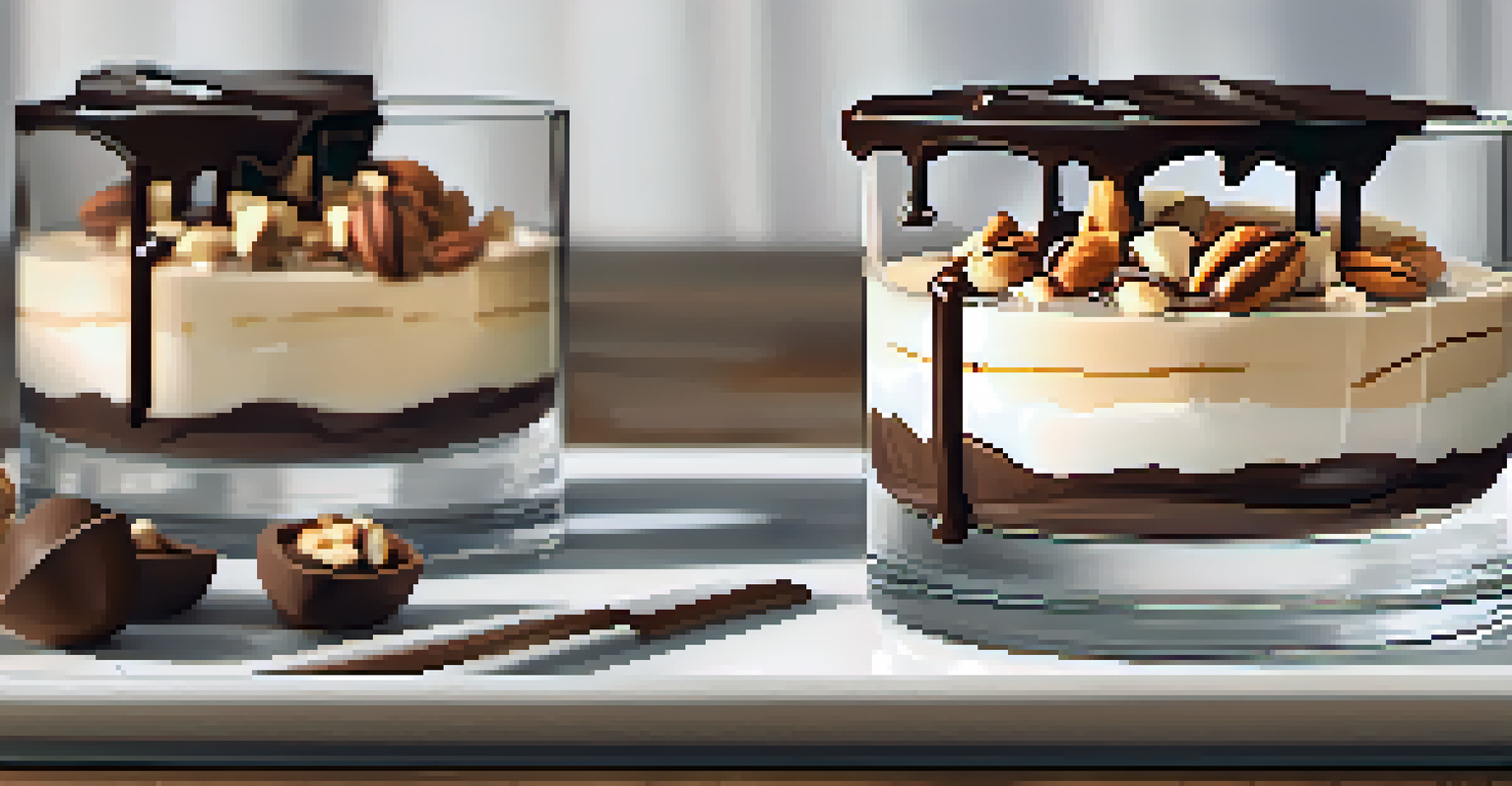The Role of Texture in Culinary Arts and Painting Styles

Understanding Texture in Culinary Arts
Texture in culinary arts refers to the way food feels in the mouth. It can range from smooth and creamy to crunchy and chewy, influencing our overall eating experience. For instance, a well-cooked risotto is creamy while perfectly roasted vegetables offer a satisfying crunch. Chefs often manipulate texture to enhance flavors and create more dynamic dishes.
The art of cooking is not just about flavors; it's about the textures that bring the dish to life.
The interplay of texture is crucial in achieving balance in a dish. Think about a classic burger: the juicy patty, crisp lettuce, and soft bun create a harmony that delights the palate. When textures are thoughtfully combined, they can elevate a dish from ordinary to extraordinary, making each bite a new experience.
Incorporating various textures also encourages creativity in the kitchen. For example, using a sprinkle of toasted nuts can add a delightful crunch to a smooth dessert. By paying attention to texture, chefs can transform simple ingredients into culinary masterpieces that engage all our senses.
The Importance of Texture in Visual Art
In painting, texture refers to the surface quality of a piece of art, whether it's smooth, rough, or somewhere in between. Artists use texture to enhance visual interest and convey emotions, much like how chefs use texture in their dishes. For instance, thick brushstrokes can evoke a sense of energy, while smooth areas can create calmness in a composition.

Texture in visual art can also be actual or implied. Actual texture involves the physical feel of the artwork, while implied texture is created through visual techniques, suggesting how the surface looks. An artist painting a landscape might use rough strokes to depict rocky mountains, while soft, blended colors evoke the gentleness of a cloudy sky.
Texture Enhances Culinary Experience
In culinary arts, texture plays a crucial role in shaping our eating experience, influencing how flavors are perceived and enjoyed.
By experimenting with different textures, artists can tell a story without using words. A mixed-media piece might combine rough materials like sandpaper with smooth paint to create a conversation about contrast, much like flavors in food. This exploration of texture invites viewers to engage more deeply with the artwork.
The Connection Between Texture and Flavor
Texture and flavor are intrinsically linked in both culinary and artistic expressions. In food, the texture can enhance or diminish the perception of taste; for instance, a creamy chocolate mousse feels rich and indulgent, while a dry cake might leave us dissatisfied. Similarly, in visual art, texture can alter the emotional response to a piece; a rough, jagged surface might evoke feelings of chaos, while a smooth surface can be calming.
Texture is what makes a painting come alive, engaging the viewer in a tactile experience.
Both chefs and artists often play with texture to surprise their audience. A dish that surprises with unexpected crunch can delight diners, just as an artwork that reveals hidden textures upon closer inspection can captivate viewers. This playful exploration keeps experiences fresh and engaging.
Ultimately, the connection between texture and flavor is about creating memorable experiences. Whether through the bite of a perfectly seared scallop or the layered texture of an abstract painting, both culinary and visual arts aim to evoke emotions and leave a lasting impression.
Culinary Techniques to Enhance Texture
Chefs employ various techniques to enhance texture in their dishes. Methods like sous-vide cooking can achieve tender meats, while frying can create a satisfying crunch. Techniques such as emulsifying can transform a simple dressing into a creamy vinaigrette, enhancing the mouthfeel and flavor of a salad.
Another way to play with texture is through layering. Think of lasagna, where layers of soft pasta, creamy cheese, and hearty sauce create a delightful combination. Each layer contributes a unique texture, making each bite a journey through different sensations.
Art Uses Texture to Convey Emotion
In visual art, texture adds depth and emotion, allowing artists to tell stories and engage viewers through varied surface qualities.
Lastly, garnishing is a simple yet effective way to add texture. A sprinkle of seeds, a drizzle of oil, or a dollop of whipped cream can elevate a dish, making it visually appealing while adding that extra crunch or creaminess that excites the palate.
Artistic Techniques to Create Texture
Artists use various techniques to create texture in their work, such as impasto, where thick paint is applied to create a three-dimensional effect. This method can add depth and dimension to a painting, inviting viewers to explore the artwork from different angles and perspectives.
Collage is another popular technique that combines various materials, adding a tactile element to visual art. By layering different textures, artists can create a rich, multi-dimensional experience that pulls the viewer in, much like the layers of flavor in a well-crafted dish.
Incorporating mixed media allows artists to experiment with unconventional materials, like fabric, sand, or even metal. This not only enhances the visual texture but also introduces new sensory experiences, inviting audiences to engage with the artwork in a more profound way.
Cultural Perspectives on Texture
Different cultures place varying levels of importance on texture in both food and art. For example, in Japanese cuisine, the texture of ingredients is meticulously considered, showcasing the beauty of seasonal produce through various cooking methods. This respect for texture reflects a deeper cultural appreciation for harmony and balance.
In the realm of visual arts, textures can convey cultural narratives. Indigenous art often incorporates natural materials that reflect the landscape and traditions of the community. By showcasing these textures, artists tell stories that connect people to their heritage and environment.
Cultural Significance of Texture
Different cultures emphasize texture in food and art, reflecting deeper values and narratives that connect people to their heritage.
Understanding these cultural perspectives allows us to appreciate how texture shapes our experiences with food and art. Whether through the crispness of a fresh vegetable or the roughness of traditional pottery, texture serves as a bridge between cultures, inviting exploration and understanding.
The Future of Texture in Culinary Arts and Painting
As culinary arts and painting evolve, the role of texture continues to expand. Innovations in cooking technology, such as molecular gastronomy, allow chefs to create unconventional textures that challenge our perceptions of food. Imagine a dish where a liquid transforms into a solid foam—this exciting play with texture can change how we experience flavors.
In the art world, digital techniques are reshaping how artists create texture. With tools that simulate physical textures, artists can experiment in ways that were previously unimaginable. This fusion of technology and creativity opens up new avenues for expression and engagement.

Ultimately, the future of texture in both fields promises to be dynamic and transformative. As chefs and artists continue to push boundaries, we can look forward to a world where texture plays an even more vital role in enriching our experiences and stimulating our senses.